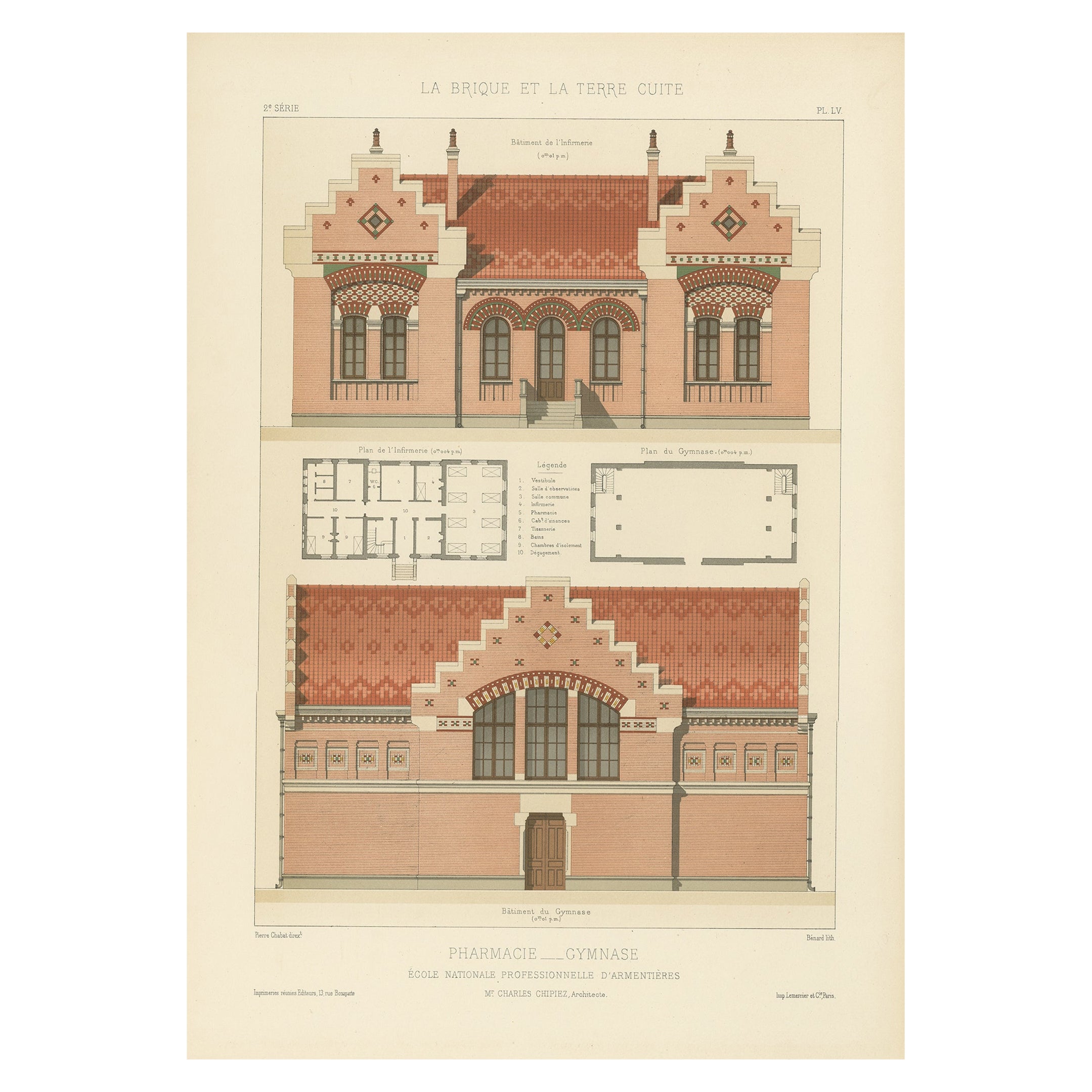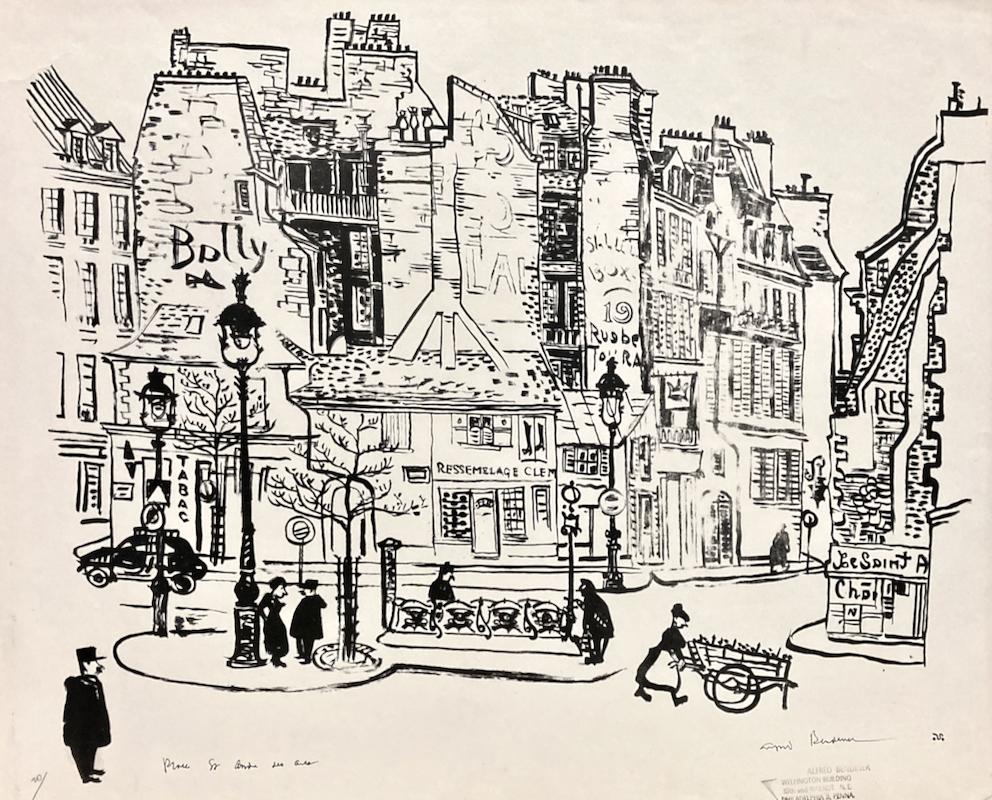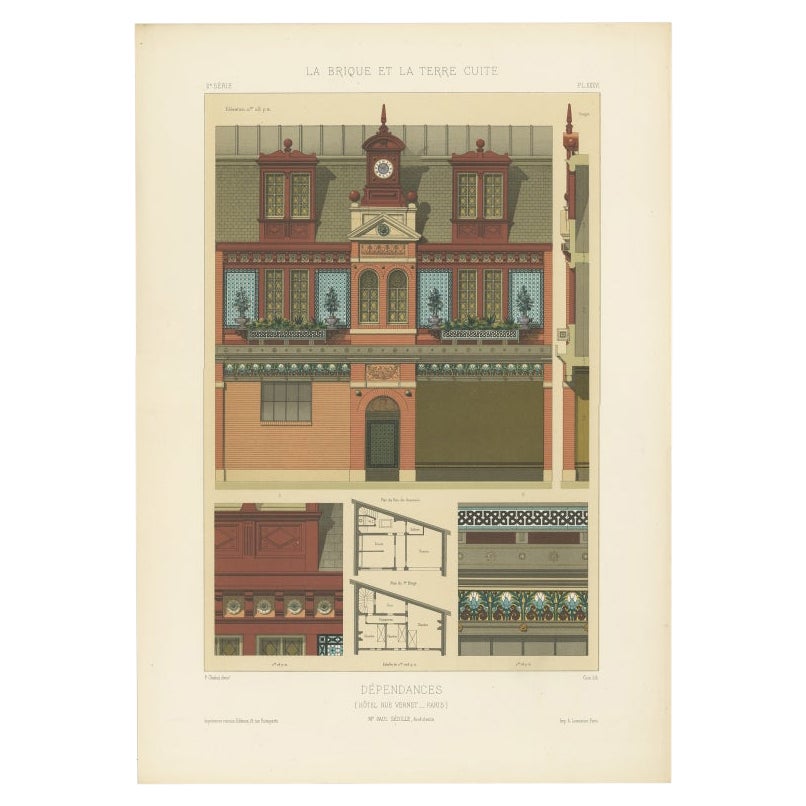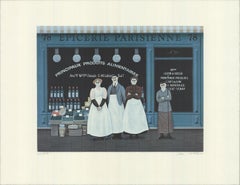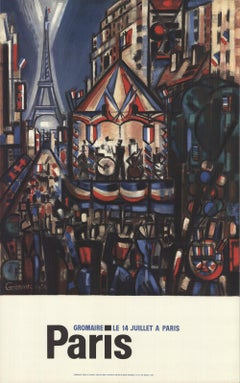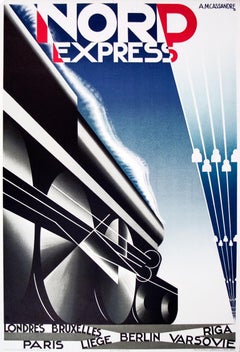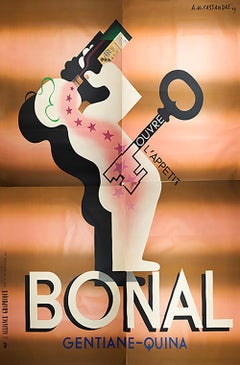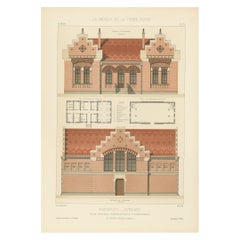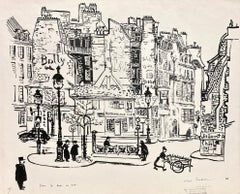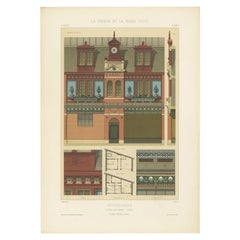Items Similar to Henry Delacroix 'Pharmacie Saint-Lazare a Paris' 1930- Pochoir
Want more images or videos?
Request additional images or videos from the seller
1 of 7
Henry Delacroix 'Pharmacie Saint-Lazare a Paris' 1930- Pochoir1930
1930
$560
$70020% Off
£422.95
£528.6920% Off
€488.81
€611.0120% Off
CA$785.49
CA$981.8620% Off
A$873.54
A$1,091.9220% Off
CHF 457.26
CHF 571.5720% Off
MX$10,656.08
MX$13,320.1020% Off
NOK 5,745.59
NOK 7,181.9820% Off
SEK 5,404.47
SEK 6,755.5820% Off
DKK 3,648.65
DKK 4,560.8220% Off
About the Item
Paper Size: 14 x 15.5 inches ( 35.56 x 39.37 cm )
Image Size: 8.75 x 10.25 inches ( 22.225 x 26.035 cm )
Framed: Yes
Frame Size:
Condition: A-: Near Mint, very light signs of handling
Supplemental Condition Information: Some small scratches and marks in plexiglas??Additional Details: Pochoir print with silvered ink on strong paper. From the portfolio by H. Delacroix, Boutiques, about 1930. Framed in a metal frame with mat with a front profile of 0.25 inch and side profile of 0.75 inch. Print has not been examined outside of frame.
Shipping and Handling: We ship Worldwide. For Domestic and International shipments alike, we use heavy, thick-walled UPS and FedEx Approved shipping tubes to ship all items that are rollable. For items that cannot be rolled, we pack the item flat.Attention International Buyers, Please Note: Import duties, taxes, and charges are not included in the item price or shipping cost. These charges are the buyer's responsibility. Please check with your country's customs office to determine what these additional costs will be prior to bidding or buying.
- Creation Year:1930
- Dimensions:Height: 14 in (35.56 cm)Width: 15.5 in (39.37 cm)
- Medium:
- Movement & Style:
- After:Henry Delacroix
- Period:
- Condition:All items are carefully stored. Condition is a main concern, unless otherwise indicated, all items are in mint condition. Additional pictures are available upon request. Feel free to contact our team if you have any questions or concerns. Thank you.
- Gallery Location:Brooklyn, NY
- Reference Number:Seller: YY25961stDibs: LU1294114412832
About the Seller
4.9
Platinum Seller
Premium sellers with a 4.7+ rating and 24-hour response times
Established in 1992
1stDibs seller since 2019
2,551 sales on 1stDibs
Typical response time: 2 hours
- ShippingRetrieving quote...Shipping from: Brooklyn, NY
- Return Policy
Authenticity Guarantee
In the unlikely event there’s an issue with an item’s authenticity, contact us within 1 year for a full refund. DetailsMoney-Back Guarantee
If your item is not as described, is damaged in transit, or does not arrive, contact us within 7 days for a full refund. Details24-Hour Cancellation
You have a 24-hour grace period in which to reconsider your purchase, with no questions asked.Vetted Professional Sellers
Our world-class sellers must adhere to strict standards for service and quality, maintaining the integrity of our listings.Price-Match Guarantee
If you find that a seller listed the same item for a lower price elsewhere, we’ll match it.Trusted Global Delivery
Our best-in-class carrier network provides specialized shipping options worldwide, including custom delivery.More From This Seller
View All'Epicerie Parisienne'- Lithograph- Signed
By Jan Balet
Located in Brooklyn, NY
Epicerie Parisienne is a charming lithograph by Jan Balet, signed and numbered out of 300 in pencil by the artist, which adds to its authenticity and collectibility. This artwork cap...
Category
20th Century Contemporary Prints and Multiples
Materials
Lithograph
$320 Sale Price
20% Off
1964 After Marcel Gromaire 'Paris, July 14th, La Bastille'
By Marcel Gromaire
Located in Brooklyn, NY
Paper Size: 38.5 x 24 inches ( 97.79 x 60.96 cm )
Image Size: 29.75 x 24 inches ( 75.565 x 60.96 cm )
Framed: No
Condition: A-: Near Mint, very light signs of handling
Addition...
Category
1960s Modern Prints and Multiples
Materials
Lithograph
$200 Sale Price
20% Off
A.M. Cassandre-Nord Express-Vintage Lithograph
By After A.M.Cassandre
Located in Brooklyn, NY
Experience a piece of art history with this second edition stone lithograph of the iconic Nord Express advertisement created by A.M. Cassandre. Originally produced in the late 20th c...
Category
20th Century Art Deco Prints and Multiples
Materials
Lithograph
AM Cassandre Advertisement for Liqueur Bonal (4 Parts) Vintage Art Deco
Located in Brooklyn, NY
This exceptional original advertisement poster by the renowned A.M. Cassandre exemplifies the pinnacle of graphic design and advertising artistry from the 1930s. Cassandre, celebrate...
Category
20th Century Art Deco Prints and Multiples
Materials
Screen
$2,800 Sale Price
20% Off
Pierre Fix-Masseau-Exactitude-40" x 25"-Lithograph-1982-Vintage-Black, Brown
By Pierre Fix-Masseau
Located in Brooklyn, NY
Reproduction in lithography of Fix-Masseau Exactitude. Copyrighted 1982 Studio Editions. Printed in France by Bedos on heavy linen like paper.
Category
20th Century Art Deco Prints and Multiples
Materials
Lithograph
Rene Genis 'Galerie Des Chaudronniers' 1984- Lithograph
By René Genis
Located in Brooklyn, NY
Paper Size: 26 x 19.5 inches ( 66.04 x 49.53 cm )
Image Size: 26 x 19.5 inches ( 66.04 x 49.53 cm )
Framed: No
Condition: B: Very Good Condition, with signs of handling or age
Su...
Category
1980s Prints and Multiples
Materials
Lithograph
$140 Sale Price
20% Off
You May Also Like
La Brique Architectural Print – Pharmacy & Gymnasium by Charles Chipiez, c.1900
Located in Langweer, NL
La Brique Architectural Print – Pharmacy & Gymnasium by Charles Chipiez, c.1900
This antique architectural lithograph presents a detailed view of the pharmacy and gymnasium at the É...
Category
20th Century French Prints
Materials
Paper
Le Printemps, Grand Magasin (Department Store in Paris) - Handsigned lithograph
By Yves Alix
Located in Paris, IDF
Yves ALIX (1890 - 1969)
Le Printemps, Grand Magasin (Department Store in Paris), c. 1930
Original stone lithograph
Handsigned in pencil
Numbered / 150 copies
On vellum 34 x 49 cm (c...
Category
Early 20th Century Art Nouveau Interior Prints
Materials
Lithograph
Alfred Bendiner, Place St. Andre des Arts (Paris)
By Alfred Bendiner
Located in New York, NY
The Place St. Andre des Arts, on the Left Bank in Paris, would have been a natural environment for Bendiner. It was the Latin Quarter, just south of the Louvre and near everything im...
Category
1950s American Modern Landscape Prints
Materials
Lithograph
Building Design Print of Hôtel Rue Vernet Paris, Chabat, c.1900
Located in Langweer, NL
Antique print titled 'Dépendances (Hôtel Rue Vernet Paris) Mr. Paul Sédille, Architecte'. This print depicts the design of a hotel in Paris, France. Originates from 'La Brique et La ...
Category
20th Century Prints
Materials
Paper
Une Marmite
By Jean-Emile Laboureur
Located in New York, NY
Jean-Emile Laboureur (1877-1943), Une Marmite, engraving, 1916, signed in pencil lower left; titled, dated and inscribed “epreuve de 1er etat” bottom margin edge [with the initial an...
Category
1910s Art Deco Figurative Prints
Materials
Engraving
The Corner Drugstore
Located in San Francisco, CA
This artwork titled "The Corner Drugstore" c. 1985 is an original sepia etching by American artist Scott Fitzgerald. It is hand signed, titled and num...
Category
Late 20th Century American Realist Figurative Prints
Materials
Etching
More Ways To Browse
Deco Pochoir Prints
Glass Stir
Oil On Tin Portraits
Peter Max 1980
Print Club Of Cleveland
Screen Printed Mirror
Sea Shell Prints
Vintage Europe Map
1984 Olympics
Chagall Jacob
Magic Poster
Peter Max Flag
Picasso Head Sculpture
Picasso Vallauris Print
Salvador Dali Green
Vintage Fantasy Posters
Vintage Fashion Two Twenty
Vintage Lobby Cards
